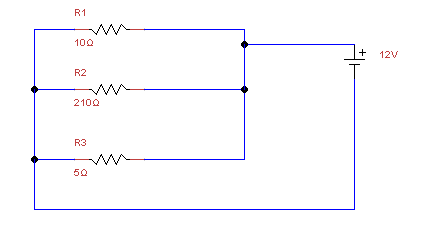This parallel circuit has 3 resistors, R1, R2, and R3 with different resistances labeled. We still have a 12v power source.

How do we know what current will be on the other side of the resistors? Note that some components can impart some resistance, and may act the same.
First we need to calculate the total resistance of the circuit.
1/Rt = 1/10 + 1/210 + 1/5 1/Rt = 0.1 + 0.005 + 0.2 1/Rt = .305 Rt = 3.28Ω
Since we know what the voltage is across all components, since this is a 12V parallel circuit, we can now calculate the circuit total amperage.
I = E/R
12V / 3.28Ω = 3.67A
Now we have the total current, we can find out what it is flowing to each component:
I1 = 12V / 10Ω = 1.2A I2 = 12V / 210Ω = .057A I3 = 12V / 5Ω = 2.4A
Because we are rounding our figures, I1+I2+I3 is not exactly It, but this is okay since this is well with tolerance levels of devices and components. Lets say now that we have a device that needs 5A to run correctly and we will connect it behind R3, how can you do this?
We can work backwards. Remember we only need three variables, and we have two!
R = 5/12 R = .416
Of course this would be an expensive and hard to find resistor, but you can see how we can calculate what we need.

